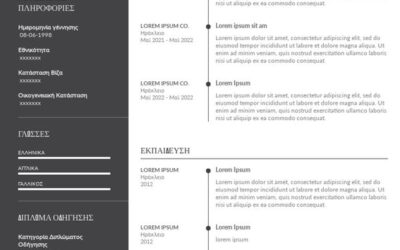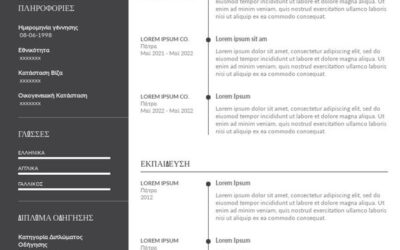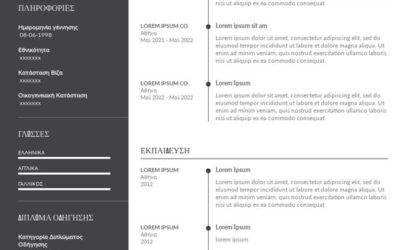Welding is a complex trade skill with a lot of demand in specific industry sectors. While the median welder’s annual salary of $47,000 is nothing to scoff at, you can earn a lot more by assembling a resume that turns the heads of hiring managers everywhere.
Let Resume-Example guide you if you’re not sure where to begin. The experience we have gained in the resume building industry has enabled us to craft the perfect cv for any occasion.
And in this guide, we’ll share our knowledge with you. Read on to learn what a welder fabricator resume should look like, as well as tips on how to write your own resume, so you can craft a resume masterpiece that recruiting specialists can’t ignore.
Welder Resume Example
Speaking about resume examples, we think that the best way to start is by showing you what a final product may look like. Here’s a winning welder resume example based on our resume templates:
Professional Welder
914-388-8210
c.brown@gmail.com
New York City, NY
Linkedin.com/in/charlesbrown
Professional Summary
Professional welder with 5+ years of experience in MIG welding. Increased project completion by 20%. Trained 5 junior welders. Received a commendation for my attention to detail and problem-solving skills.
Work Experience
MetalWorks Inc.
Welder and Supervisor
March 2017 – Present
- Trained 5 junior welders, improving work quality by 20% and project completion by 10%.
- Reduced work-related accidents by 40% by enforcing compliance with safety procedures.
- Completed welding projects 15% faster than average without compromising quality.
Education
Certified Welder Program
American Welding Society
2014-2015
3.0 GPA
Skills
- FCAW, SMAW, and GMAW welding
- ISO-9001 trained
- Detail oriented
- Problem-solving skills
Certifications
- Certified Resistance Welding Technician (CRWT)- 2016
- Certified Welding Engineer CWE – 2015
Languages
- English – Native – TOEFL score of 100
If you are interested in examples for other careers, check out our other resume examples.
How to Make a Welder Resume from Zero
Welding is a trade-based career, and as such, experience and skills are the most critical factors for recruiters. You’ll want your resume to highlight the welding techniques you know, the projects you’ve worked on, and the tools you can use.
Furthermore, you want a resume that shows you are a detail-oriented person that can solve problems as needed.
If you are not sure how to write a resume that paints that picture, you can just follow our tips and examples.
For starters, a great welder resume should have all the following sections:
- The header
- A resume summary
- An overview of your work experience
- A recap of your education
- A breakdown of your skills
- Additional sections such as certifications, languages, or projects
If you don’t have a lot of work experience, you can substitute the resume summary for a resume objective. As for the actual work experience section, you can do away with it and focus more heavily on your skills, goals, and any welding projects you’ve done that could help showcase your talents.
A welding resume that’s customized for the job you are applying to will do much better than a general one. Here are some tips to help you personalize your resume for each occasion:
- Pay attention to the keywords and action verbs used by the hiring manager in the job description. Mirror these words naturally in your resume to get past any applicant filtering systems they may use.
- Tailor your resume for each specific job as much as possible. This could mean changing the format, switching the order of your skills based on relevance, or replacing some of the additional sections for others that are more important based on context.
- Make sure your resume is concise and to the point, as it shouldn’t be longer than one page.
- Make sure to check for and correct any grammar or spelling errors.
What Should a Welder Resume Look Like?
While welder resumes tend to follow the same structure, there are different formats you can choose depending on what you want to highlight.
The three format options you can use are:
Reverse Chronological
First on the list is the most popular format choice, and for a good reason. The reverse-chronological format highlights your work experience, starting from your current or most recent job, then working its way back. For a welding resume, where your skills and experience should be the star of the show, this makes the most sense. It provides a good overview of what you can handle based on objective work experience.
Functional
The functional format is a better choice for entry-level welder resumes. Instead of focusing on work experience, this format highlights your transferable skills and knowledge, while also leveraging your objectives. It’s commonly used for welders new to the industry, or people changing careers.
Combinational or Hybrid
Last but not least, we have the combinational or hybrid format. As the name implies, this format combines aspects of both options by including a balance of work experience and transferable skills. While this might sound like the best choice, you have to remember that a resume needs to be concise. Choose this format if you feel that your work experience alone doesn’t provide enough background but be mindful of your resume’s length.
As for the resume’s design layout, you should adhere to the following guidelines:
- Margins: one inch on all sides.
- Font style: use a neutral font like Calibri, Arial, Times New Roman, or Cambria.
- Font size: 10 to 12pts.
- Line spacing: Either 1.0 or 1.15.
- Resume length: No longer than one page.
One of the most important aspects of a resume is that it’s concise and easy to read. Following the above should help you accomplish that in terms of layout.
Dos and Don’ts for the Header and Contact Section
It’s very important that your header section and contact information are formatted properly, as these are the first things a recruiting manager will see. You can’t afford any mistakes here.
However, you don’t want to overdo it either. Remember that space is of the essence.
A solid header and contact section will include, in this specific order, your full name, job title, phone number, email, city and state where you live, and either your professional profile from LinkedIn or a personal blog or website.
This is what a good header looks like:
Great example of a header for a welder resume
Professional Welder
914-935-6284
j.jameson@gmail.com
New York City, New York
Linkedin.com/in/jamesjameson
Clean, professional, and concise.
And this is what you want to avoid:
Bad of a header for a welder resume
Master Welder
914-935-6284
the_weldinator@gmail.com
59 W 46th Street
New York City, NY 10036
DoB 21/04/89
Linkedin.com/in/jamesthewelder
Notice how it shares more information than needed and uses a contact email that doesn’t look very professional.
You might be tempted to include a photo of yourself, but we don’t really recommend it. There are a few reasons why pictures are not a good idea. They take up space on your resume and are actually disliked by recruiters. Plus, by including a picture, you are introducing the possibility of unconscious bias or discrimination based on it.
However, in the off chance that they specifically ask you for one, make sure it’s 1.5 to 2 inches square and taken with a blank background. This picture size is commonly known as 2×2, or passport style.
How to Demonstrate Your Experience in Welding
This is the core of a welding resume. Here’s where you show that you got what it takes to do the job. In the welding industry, your work experience is a presentation card that backs up your skills and knowledge for hiring managers.
By looking at your previous jobs and projects, they can know what kind of skills you have, and whether they fit the criteria they need.
You’ll want to follow the reverse-chronological format for this section. That means starting from your most recent job and doubling back. You’ll want to include the name of the place, your position, the length of time you worked there, and 3 to 5 of your accomplishments or responsibilities during that time. Here are some examples of what that looks like:
Example for Juniors
If you have limited work experience, it could look something like this:
Pipetron Construction
2021-Current
Performed welding to resolve flaws in structures.
Assessed welded surfaces to determine defects.
Completed a $50.000 welding project 2 days ahead of schedule.
Example for Seniors
For seniors, your work experience section might look like this:
Welder Supervisor
2015-Current
Trained a team of 5 junior welders and increased project completion by 15%.
Improved work quality by 20%.
Consistently completed projects 20% faster than the average welder.
Describe Your Welding Education
For the education section, you’ll normally focus on the welder courses or programs you’ve taken, starting with the most recent one. You’ll need to include the program’s name, the name of the place where you took it, the years you studied, your GPA, and the relevant tests you took.
Good example
American Welding Society
2010-2012
3.0 GPA
Relevant tests: Structural steel welding
The Most Sought-After Skills on a Welder Resume
As with any trade-based career, welding is a profession centered around your individual skills. As such, you’ll want to make sure that the hiring manager gets a good picture of what you can do just by looking at your resume. However, that doesn’t mean you should list every single thing you know. You’ll want to focus first and foremost on the skills that are relevant for the specific job you are applying to.
As a welder, you’ll be expected to read and understand blueprints for projects that you’ll handle. Precision is also fundamental, as well as having an eye for detail. Not to mention that you need to show you know the specific welding techniques or technologies used in that particular industry.
The best way to show that is by providing a list of skills that combines both hard and soft skills. Hard skills are those you train for or learn through studying, such as welding techniques, tool handling, or the use of industry-specific software. On the other hand, soft skills are related to who you are as a person and are more about your mental and physical capabilities.
A good skills section will have both types, while still focusing on the skills that connect the most with the application’s requirements.
These are some of the most sought after hard and soft skills for the welding industry:
Hard Skills for Welders
There are many welding processes and techniques to learn, as well as training to undergo. Among the hard skills a welder can have, you’ll find the following:
- ISO9001 trained
- FCAW
- SMAW
- GMAW
- Oxy-Fuel welding
- Pipe welding
- 35 to 3/32 wiring
- Robotic welding handling
- Design skills
Soft skills for Welders
When it comes to personal and interpersonal skills, a good welder should have the following:
- Attention to detail
- Collaboration and communication
- Problem solving
- Math skills
- Time management and organization
- Steady hands and good hand-eye coordination
- Physical and mental endurance
- Dexterity, mobility, and flexibility
- Ability to learn new technologies and techniques
Write a Winning Professional Summary
According to studies, recruiters spend between 6 to 8 seconds looking at a resume, so you have to make every second count. How can you do that?
By writing a killer resume summary.
Your resume summary is your sales pitch. It’s a short 2 to 3-lines paragraph that provides the hiring manager with a specific, brief, and objective look at who you are and what you can do.
You’ll want to throw an eye-grabbing detail in there to ensure that they keep reading, such as one of your accomplishments with numbers to back it up.
Here are some examples of what a good resume summary looks like:
Extra Sections to Add More Weight to Your Resume
The last sections of your resume can help round out your application by providing supporting details. Your certifications, awards, personal projects, interests and hobbies, and languages are some examples of things you can share here. These elements can help make your resume more unique and give you an edge over other applicants.
These are some of the extra sections you can use for a welding resume:
Certifications
Welding certifications can help prove your abilities, verify your quality level, and show your versatility. Here are some of the main welding qualifications out there:
- Certified Welder (CW)
- Certified Resistance Welding Technician (CRWT)
- Certified Radiographic Interpreter (CRI)
- Certified Welding Engineer (CWE)
- Certified Welding Inspector (CWI)
You can also include an “Interests” section to highlight what hobbies or passions you have that could blend into the job. But it’s really needed if you already have everything else covered.
Languages
Managing multiple languages isn’t necessarily something you’ll need as a welder, but it doesn’t hurt to include it. Make sure to order your languages based on fluency and include the certification scores you have to prove your knowledge.
This is an example of what it could look like:
- English – Native – TOEFL score of 100
- Spanish – Fluent – SIELE C1 score of 900
Projects
If you’ve done side-gigs or personal projects related to welding, make sure to include those too. For instance, if you’ve repaired a car or have your own YouTube channel or blog about welding.
Key Takeaways: Write a Resume for Jobs in Welding
At this point, you should know everything you need to write the perfect job welder resume. To help you bring it all together, here’s a quick recap of the main points in our guide:
- The structure of your resume should be: header, resume summary, work experience, education, skills, and finally, additional sections.
- Keep your resume’s length to one page.
- Make sure your header doesn’t have any errors, and that it includes updated contact information.
- Time is of the essence, so make sure your resume summary objective can catch the recruiter’s attention right from the start.
- If you have work experience, use the reverse-chronological format to highlight it. If you have limited or no work experience, use either the functional or hybrid format instead.
- It’s important that you use numbers to quantify your accomplishments. Specificity is more appealing than vague statements.
- Round out your resume with additional sections, such as your welding certifications or the projects you’ve worked on.
Complement Your Resume with a Cover Letter
Last but not least, you’ll want to have a great cover letter to support your resume and give a better picture of who you are. You should always include one of these in your job applications unless the hiring managers specify not to.
A cover letter gives you the freedom and space to really tell your story and show what you can offer to your potential new employer. You can only include so much on a resume, and a cover letter can help you round out your presentation.
If you don’t know how to write one, we got you covered. Just use one of our cover letter templates. Even if you’ve written cover letters before, you’ll find that using a template saves you a lot of time, and helps you organize your ideas better.
If you use one of our templates for guidance, you’ll surely write a letter that wows any recruiter.
Frequently Asked Questions
As a final treat, we bring you the answers to some of the most frequent questions asked about welding jobs:
What Are the Duties and Responsibilities of a Welder?
Welders are responsible for repairing damage to metal components or assembling pieces of metal together using machinery that emits high heat to melt the metal into the desired shape.
The list of duties and responsibilities of a welder includes, but is not limited to:
- Sourcing the materials needed to work on a project
- Reviewing and understanding the blueprints of a project before starting
- Measuring and cutting materials following specifications
- Welding the correct materials to join metals together
- Ensuring that the finished work falls within the tolerances specified by the project’s blueprints
Where Are the Best Welding Jobs Found?
In the world of welding, salaries can vary a lot depending on your location, the type of welding, and the industry you are working in. Currently, these locations and industries offer the best paying welding jobs:
- The manufacturing industry in Wyoming or Nevada
- The oil industry in North Dakota
- The energy in Wyoming and West Virginia
- Aerospace and Automotive industries in West Virginia
- Shipyard and pipeline construction industries in Alaska
- Offshore oil rigs in Hawaii
- The U.S. military




